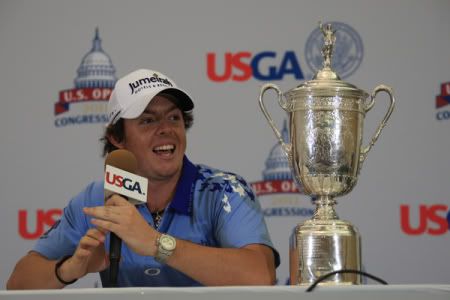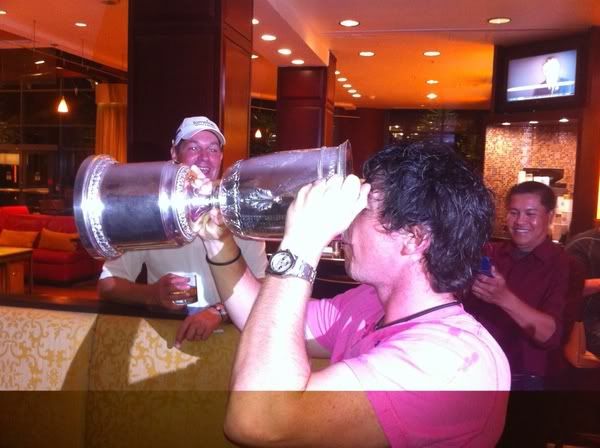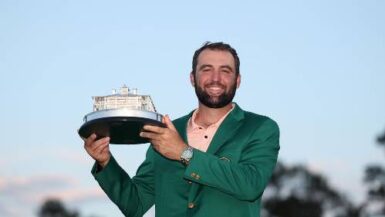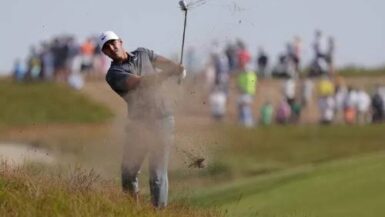
BETHESDA, MD – The lightning blinded the eyes of all the spectators with its burnished reflection of the sun off the shaft of Rory McIlroy’s hybrid. We first heard the “Thwack!” as the clubface spoke its single word, and then the golf ball soared skyward, waving to Snoopy 2 as it cruised by on its way to the 10th green at Congressional Country Club’s Blue Course during the final round of the 111th U.S. Open.
Then came the inevitable thunder – a long rippling peal, rising like a storm and resounding like a cannon blast as the ball crept closer and closer to the hole and the kick-in birdie that would increase McIlroy’s lead to a gargantuan nine shots. On and on it echoed, commanding the attention of everyone on the golf course, mesmerizing them with the enormity of the moment.
There was the biggest roar of the tournament. There was your defining moment.
With a routine par at the brutally long and criminally narrow 11th, the worst of Congressional was behind Rory McIlroy, and he could take a long, seven-hole victory lap, one rousing curtain call after another, rightfully basking in the esteem and admiration of the entire Golf World and re-writing the U.S.G.A. record books in green ink.

“I knew right then that it was my tournament to lose, and I had to make that I didn’t do anything stupid to lose it,” he recalled laconically.
“Something stupid” in that case would have been to fall off the swinging bridge over the lake and into the muck, because Congressional was first declawed by the heat and rain, then dissected by the field. The 20 sub-par totals for 72 holes are the second-most all-time in U.S. Open history behind the 28 at Medinah in 1990. The 108 sub-par rounds for the championship are the second-most all-time in U.S. Open history behind the 124 at Medinah in 1990. And the 32 sub-par scores in the fourth round are the most all-time in U.S. Open history, breaking the previous record of 18 at Baltusrol in 1993. Congressional wasn’t going to beat him, and the field just couldn’t keep up.
McIlroy was a force of nature all week, becoming just the fourth player to post four consecutive rounds in the 60s. (For those of you scoring at home, the others are Lee Janzen at Baltusrol in 1993, Lee Trevino in 1968 at Oak Hill and Billy Casper in 1966 at Olympic Club, although one of Casper’s was in the playoff.) He was also the sixth player to win the U.S. Open wire-to-wire with no ties.
No one was going to catch him. Lee Westwood was, typically, Lee Westwood, having just enough to finish in the top 5, but not enough to power to the top. Jason Day put up a good fight, from started from too far back. And Rory certainly wasn’t going to get beaten by a guy dressed like he has a sponsorship deal with Garanimals, so Y.E. Yang, if you don’t want to have guys take you seriously on the first tee, wear some shirts that aren’t so cuddly-cutesy. Puke-a-tronic!

No, McIlroy’s biggest opponent was his past, a gorilla on his back in the form of missed chances at the Masters, PGA, and British Open, and yesterday he beat that monkey to death with his irons on his way to owning, indeed shattering multiple U.S. Open records, including the lowest 36, 54, and 72 hole aggregates and the score in relation to par. In total, he set or tied twelve different U.S. Open records.
Fellow Northern Irishman Graeme McDowell told everyone Rory’s nickname in Europe is BMW because he drives so well, but it was Rory’s laser-precise iron play that he won this U.S. Open. He was first in Greens in Regulation, hitting 62 of 72 (for a whopping 86%).
“He’s the best driver of the golf ball I’ve ever seen,” which may be true, but Rory didn’t need that. He only hit 64% of his fairways, good for T-26, but he was 6th in putting and first birdies. He carded just two bogeys and one double for the entire week.
There was a second defining moment of the tournament as well, and it came a day earlier. As McIlroy putted out on the 18th green the 30,000 people in that cavernous amphitheatre that encompassed 10 as well as 18 broke out in a cheer of “Let’s go, Rory!” Over and over they serenaded him, all evening, deep into the night, and all the next day during his coronation.
And how did Rory respond?
“I might just hgave to play more in the U.S.,” he said, and Congressional rang with the cheering.
American golf fans embraced Rory like he was one of their own. Youth and talent: that’s all golf fans want. That and clean cut, forthright role models the kids can look up to and admire. It’s not Tiger Woods per se that golf needs, just a champion or two, just compelling battles and fascinating stories of success, redemption, and triumph.
Matinee idol looks, freckles, and a mop-top help a bit too, but it’s the attitude that endeared him to us, won us over in the end.
“I learned so much from the loss at Augusta, it was a valuable experience for me. I knew what I needed to do today to win,” he explained. “I put a few different things into practice, and they worked.”
And so by Saturday, the golf fans had spoken more loudly than the broadcast media ever could. Tiger Woods was forgotten, and the changing of the guard stood at attention. There was McIlroy, just in front of gallant young Jason Day, another young star streaking into the stratosphere with meteoric speed. There were Russell Henley and Patrick Cantlay, two young college kids, swashbuckling their way on to the leaderboard with a riveting, spirited battle for low amateur. And there was the entire golf world, marveling at a magnificent, historic tournament.
The names and the faces change, but golf remains the same. There’s always going to be a Tiger Woods. Great players are always rising and falling, but we still see our share of immortals if we just give the game time to introduce us to them. Golf – and indeed life – are cyclical. If we can wean ourselves off of our instant gratification addiction, we can appreciate so much more.
In the meantime, as I leave you to your morning bagel or coffee and I head back to New York City and its lullaby of jackhammers and sirens, consider this: no less a personage than Dan Jenkins himself said, “I’ve covered almost 60 U.S. Opens, and this one joins my top five, with Hogan in 1951, Arnold in 1960, Jack in 1962 and Tiger in 2000.”
And this is only the beginning for McIlroy. St. George’s is just three weeks away, so fasten your seat belts. With the way he’s playing, we’ll have many more years to say, “the best is yet to come.”
NEWS, NOTES, AND QUOTES
Rory to Bob Costas: “I know how good Tiger was in 2000 to win by 15 at Pebble and I tried to go out and emulate it.”
Rory to Dad: “It means the World to have you here today, happy Father’s day, this one’s for you.”
Rory to the fans: “A lot of Guiness is going down tonight, I hope they keep the pubs open a little later.
A stat to consdider for my retrospective tomorrow – isn’t it ironic that the highest aggregate at Congressional was at a PGA (281)?




